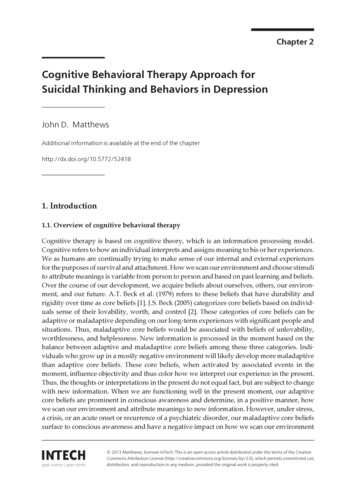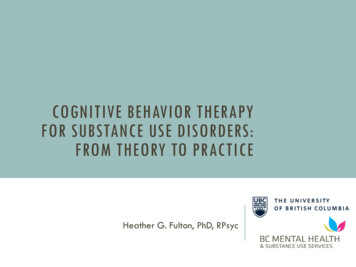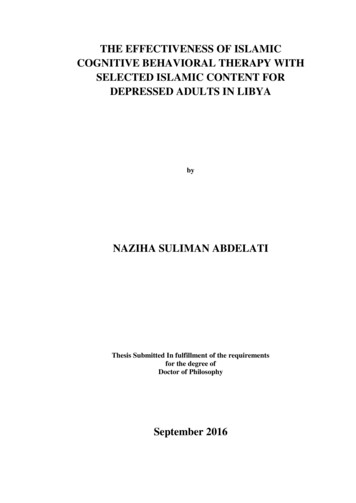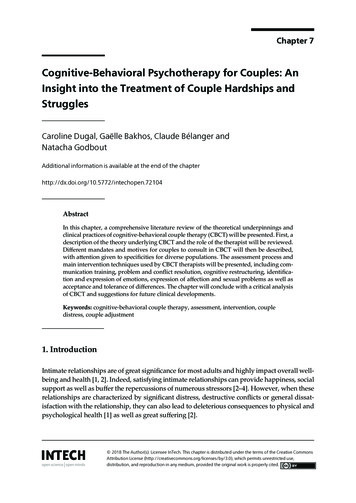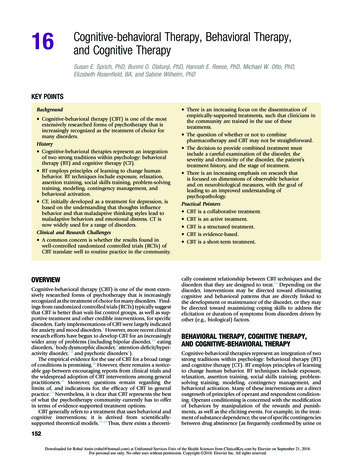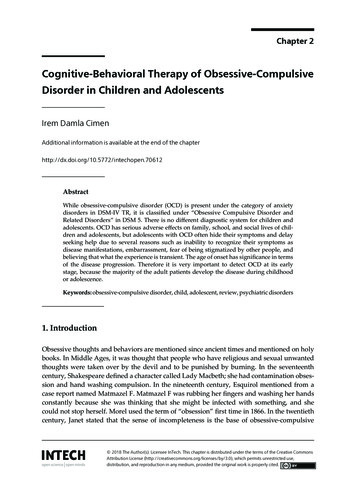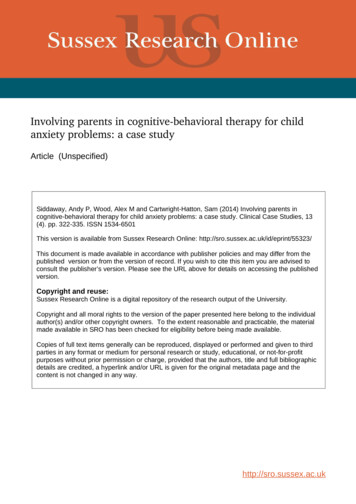
Transcription
Involving parents in cognitive behavioral therapy for childanxiety problems: a case studyArticle (Unspecified)Siddaway, Andy P, Wood, Alex M and Cartwright-Hatton, Sam (2014) Involving parents incognitive-behavioral therapy for child anxiety problems: a case study. Clinical Case Studies, 13(4). pp. 322-335. ISSN 1534-6501This version is available from Sussex Research Online: http://sro.sussex.ac.uk/id/eprint/55323/This document is made available in accordance with publisher policies and may differ from thepublished version or from the version of record. If you wish to cite this item you are advised toconsult the publisher’s version. Please see the URL above for details on accessing the publishedversion.Copyright and reuse:Sussex Research Online is a digital repository of the research output of the University.Copyright and all moral rights to the version of the paper presented here belong to the individualauthor(s) and/or other copyright owners. To the extent reasonable and practicable, the materialmade available in SRO has been checked for eligibility before being made available.Copies of full text items generally can be reproduced, displayed or performed and given to thirdparties in any format or medium for personal research or study, educational, or not-for-profitpurposes without prior permission or charge, provided that the authors, title and full bibliographicdetails are credited, a hyperlink and/or URL is given for the original metadata page and thecontent is not changed in any way.http://sro.sussex.ac.uk
1039813CCS13410.1177/1534650113510398Clinical Case StudiesSiddaway et al.ArticleInvolving Parents in CognitiveBehavioral Therapy for ChildAnxiety Problems: A Case StudyClinical Case Studies2014, Vol. 13(4) 322 –335 The Author(s) 2013Reprints and : 10.1177/1534650113510398ccs.sagepub.comAndy P. Siddaway1, Alex M. Wood2,and Sam Cartwright-Hatton3AbstractThis case study examines how parents can be incorporated into all aspects of cognitive-behavioraltherapy (CBT) for child anxiety problems. This is an important issue, because although thereare strong theoretical and empirical reasons for incorporating parents into treatment, evidencefrom randomized controlled trials has so far been inconclusive about whether outcomes areimproved by involving parents. This case study describes the clinical benefits of a balancedfocus on parent and child factors for “Laura,” an 8-year-old girl experiencing a range of fearsand worries, including refusing to attend school. Treatment consisted of seven sessions ofCBT, which targeted parent and child factors hypothesized to be critical to the developmentand maintenance of Laura’s anxiety problems. The clinician’s decision making and reasoningin carefully selecting CBT interventions to specifically address the presenting problems areillustrated. Laura showed marked reductions in avoidance behaviors and fears and returnedfull-time to school.Keywordschild anxiety, cognitive-behavioral therapy, theory1 Theoretical and Research Basis for TreatmentAnxiety disorders are among the most common psychological problems of childhood and adolescence (Kessler et al., 2005; Rapee, Schniering, & Hudson, 2009). Studies indicate that approximately 2.5% to 5% of children and adolescents meet criteria for an anxiety disorder at any onetime (e.g., Costello, Mustillo, Erkanli, Keeler, & Angold, 2003; Ford, Goodman, & Meltzer,2003). Anxiety disorders in childhood present a major concern for clinicians and researchersalike because they can have significant and long-term negative consequences on cognitive development (Creswell & Cartwright-Hatton, 2007), school performance (Essau, Conradt, &Petermann, 2000), and social and family functioning (Wood & McLeod, 2008). They are alsoassociated with the development of other disorders, such as depression, conduct disorder, andattention deficit disorder (Bittner et al., 2007; Woodward & Fergusson, 2001), and increase the1Universityof Hertfordshire, Hatfield, UKScience Centre, Stirling Management School, University of Stirling, Stirling, UK3University of Sussex, Brighton, UK2BehaviouralCorresponding Author:Andy P. Siddaway, Department of Psychology, University of Hertfordshire, Hatfield AL10 9AB, UK.Email: andysiddaway@gmail.comDownloaded from ccs.sagepub.com at University of Sussex Library on July 14, 2015
323Siddaway et al.risk of anxiety disorders in adulthood (Kim-Cohen et al., 2003). As a result of these concerns,research into childhood anxiety disorders has burgeoned in recent years. A number of authorshave reviewed the literature relating to risk factors, onset, theoretical explanations, and treatments (e.g., Chorpita & Barlow, 1998; Creswell & Cartwright-Hatton, 2007; Farmer, Eley, &McGuffin, 2005; Field, 2006; Field & Lester, 2010; McLeod, Wood, & Weisz, 2007; Mineka &Zinbarg, 2006; Murray, Creswell, & Cooper, 2009; Rapee et al., 2009; Stallard, 2005; Wood,McLeod, Sigman, Hwang, & Chu, 2003). Across these reviews, there is a clear consensus that thedevelopment and maintenance of child anxiety problems is due to a complex and dynamic interplay of neurobiological, developmental, temperament, psychosocial, and parenting factors.Numerous clinical trials have demonstrated that cognitive-behavioral therapy (CBT) is ahighly effective treatment for childhood anxiety disorders, regardless of format (Breinholst,Esbjørn, Reinholdt-Dunne, & Stallard, 2012; Hudson et al., 2009; In-Albon & Schneider, 2007;James, Soler, & Weatherall, 2005). Given significant and consistent evidence regarding thepotential influence of parental risk factors in the development and maintenance of child anxietyproblems (see the reviews cited above), various trials have evaluated whether including parentsin treatment confers an additional benefit to solely working with young people. In addition topotentially targeting important parental risk factors, there are also strong theoretical reasons forincluding parents in the treatment of child anxiety problems. For instance, as a result of thisinput, parents may learn alternative, more constructive ways of thinking, behaving, and parenting, which could enhance the child’s treatment effect by removing important risk factors andadding important protective factors (Cartwright-Hatton, Laskey, Rust, & McNally, 2010;Stallard, 2005). Parental involvement in treatment may also facilitate and reinforce the successful learning, maintenance, and generalization of new skills and perspectives into the child’s andfamily’s everyday life, during and after treatment (Spence, Donovan, & Brechman-Toussaint,2000; Stallard, 2005).However, to date, parental involvement in the treatment of child anxiety problems has oftenbeen done in an idiosyncratic and atheoretical fashion, leading to inconsistent and confusingrandomized controlled trial results (Creswell & Cartwright-Hatton, 2007). For instance, in sometreatment programs, parents were involved minimally; whereas in others, they were activelyinvolved throughout treatment. For this reason, the trials incorporating parents in treatment havebeen reviewed to explore why, despite strong theoretical and empirical reasons, parental involvement has not clearly and consistently enhanced outcomes so far (Breinholst et al., 2012; Creswell& Cartwright-Hatton, 2007). These reviews highlight a number of factors that might account forthe current results, and they identify large variation in how many and which of the empiricallyderived parental factors have been targeted and measured in treatment studies (Breinholst et al.,2012; Creswell & Cartwright-Hatton, 2007).In this article, we present a case study that illustrates in detail how parents can be involvedin all stages of CBT for child anxiety. We outline a flexible, individualized approach to CBTassessment, formulation, and treatment (Kuyken, Padesky, & Dudley, 2009; Persons, 2008) thatappears to have been relatively absent in the literature to date (Breinholst et al., 2012; Creswell& Cartwright-Hatton, 2007), and demonstrate how specific CBT techniques were carefullyselected to target only those factors seen to be critical to the maintenance of child anxiety problems for this specific family, at this specific time. In providing an individualized, tailoredapproach, we address concerns raised by Breinholst et al. (2012) that child anxiety treatmentsneed to be “tailored to the specific family rather than strictly adhering to structured manuals”(p. 422) and that parental treatments to date have targeted too many things at once—in doing so,“failing to target any one behaviour adequately” (p. 422). We illustrate how parents can beincorporated into every stage of child anxiety CBT by describing the interplay between childanxiety theory and evidence, emerging clinical information, and the clinician’s thinking anddecision making.Downloaded from ccs.sagepub.com at University of Sussex Library on July 14, 2015
324Clinical Case Studies 13(4)2 Case Introduction“Laura” was an 8-year-old White-British girl referred for psychological therapy by her generalpractitioner. She was seen in a U.K. Tier 3 Child and Adolescent Mental Health Service (CAMHS).The therapist was a 2nd-year male graduate student in clinical psychology with 7 years of clinicalpractice experience. He was supervised by a qualified clinical psychologist.3 Presenting ComplaintsLaura and her parents described various anxiety problems that manifested as reluctance to attendschool, reduced engagement with schoolwork and other children, being sent home from schooldue to fears, and avoidance of everyday places (e.g., visiting familiar shops) and previouslyenjoyed hobbies (e.g., dance class). At the start of therapy, these fears had worsened to the extentthat Laura had recently stopped attending school.4 HistoryLaura’s parents reported that her upbringing was stable, her developmental milestones were metwithout incident, and that there had not been any significant life events or difficulties. Theyreported that Laura had worried about a range of things for many years, that she had a sensitiveand anxious personality, and that she was very attuned to and aware of other people’s feelings.Laura’s mother reported that she herself had felt very anxious at school when she was Laura’s ageand that her mother in turn had been “a worrier.” Parent reports indicated that Laura’s avoidantbehaviors appeared to have started shortly after the relatively recent death of her maternal grandfather. Laura previously had infrequent contact with her grandfather and her relationship withhim was described as not being particularly close.5 AssessmentLaura and her parents attended the assessment. As is customary in U.K. CAMHS, the Strengthsand Difficulties Questionnaire (SDQ; Goodman, 1997) was completed pre- and post-treatment(see Table 2). Laura’s age meant that only the parent version could be completed. The SDQ consists of 25 items covering five subscales and has good reliability and validity (Goodman, 2001).A detailed clinical interview was also conducted, which followed Stallard’s (2005) “PRECISE”guidelines for working with children (Partnership working, Right Developmental Level,Empathy, Creative, Investigation and Experimentation, Self-discovery and efficacy, andEnjoyable). The clinical interview adopted a balanced coverage of individual and systemic predisposing, precipitating, perpetuating, and protective factors (Stallard, 2005). In terms of familyconstellation factors that may be relevant when interpreting this case, Laura has an older sisteraged 11 years, but Laura’s parents reported that the sister has a more extroverted and confidentpersonality and did not have any mental health problems. Laura’s sister did not attend any of thetherapy sessions as this was not clinically indicated and the sessions took place in school time.Laura’s parents are 40 to 45 years old and both in professional jobs. They reported a solid relationship together, although this was not formally assessed. Laura’s parents presented as verynurturing, gentle, and concerned toward Laura.Laura presented as very shy during the assessment session (sitting on her father’s lap and timidly answering “don’t know” to the initial rapport-building and scene-setting questions). The clinician adapted to this presentation by asking Laura to draw a picture of her school, with the rationalethat a picture might provide further useful information about key cognitions while also making thefocus of the session less intense for Laura, thereby facilitating engagement. While Laura wasDownloaded from ccs.sagepub.com at University of Sussex Library on July 14, 2015
325Siddaway et al.drawing, her parents described how she had now missed six weeks of school and outlined thegradual expansion of her avoidant behaviors over time. Information on developmental factors,presenting problems, family functioning, and how Laura’s fears were parented, was elicited(Stallard, 2005). The clinician also elicited Laura’s parents’ cognitions around the anxiety problems, validated concerns and frustrations, and tried to provide hope for change. Laura’s parentsviewed the anxiety problems in a similar way. Various potential difficulties at school (e.g., socialdifficulties with friends or teachers, academic/neurocognitive difficulties, bullying) were exploredand ruled out. Laura had not received any form of intervention prior to this referral and was nottaking any medication. Laura’s parents denied any mental health problems themselves.During the assessment, the clinician alternated between talking with Laura and talking with herparents, with the aim that everyone felt equal, valued, and validated. The discussion included someproblem-free talk about untroubled areas of the family’s life in order to gain a broader picture of thefamily and identify strengths that could be used in treatment (Kuyken et al., 2009). Recent examples of difficulties were discussed, as well as exceptions where Laura had faced her fears. The clinician was careful here to balance eliciting information, understanding and validating problems, andsearching for strengths that had been overlooked by the family. This approach not only helped thefamily feel understood but also began to open up new behavioral possibilities and move the familytoward their goals (Kuyken et al., 2009). Laura’s drawing (a positive image of her next to schoolbuildings) was consistent with her own and her parents’ verbal reports (i.e., that her school avoidance was not due to avoidance of bullying, for example). The drawing put Laura at ease and she andthe clinician were able to chat about the drawing and then about Laura’s fears. When more relaxed,Laura reported that she was often concerned about vomiting when she feels anxious and that shewanted to return to school. Laura could not explain her school avoidance; her developmental levelmeant that specific cognitions either were not present or could not be described, so the clinicianinferred key cognitions from discussions of triggers and from parent reports. Each person’s stage ofchange was also assessed, for example, by asking how much each person would like the problemsto go away and why. There was no information to suggest that Laura’s symptoms provided a “secondary gain” for any family member. A plan was made that Laura’s parents would liaise with herschool to pass on to teachers the therapeutic strategies suggested in sessions. The assessment endedwith a brief discussion that the forthcoming therapy together would involve graded exposure.6 Case ConceptualizationThe presenting problems were fear and worry around being independent or being in unfamiliarenvironments, avoidance of a range of places and experiences as a way to to cope with thesefears, and misinterpreting anxiety symptoms as a sign that Laura might vomit. In keeping withthe literature, multiple interacting individual and systemic factors were considered when makingsense of this case. The reported and observed information suggested that Laura has an anxioustemperament and attachment style, and that this may have been learned or inherited in part fromher mother’s side of the family. These factors may have led to Laura being more vulnerable todeveloping anxiety problems. Laura’s developmental level may have also acted as a predisposingfactor because (a) fears about independence are common in children her age, (b) parents supplythe majority of information about the world to children, and (c) an 8-year-old’s cognitive style ismore global and categorical (e.g., good vs. bad), making nuanced understanding less likely(Grave & Blissett, 2004; Stallard, 2005).An interactional perspective was used to conceptualize the development and maintenance ofLaura’s presenting problems. The death of Laura’s maternal grandfather was hypothesized to haveled to changes within the family (e.g., increased expression of distress by Laura’s mother in particular); Laura’s sensitive temperament and close attunement to other’s feelings meant that she may haveresponded to the death and the systemic changes by becoming more anxious (i.e., developing anDownloaded from ccs.sagepub.com at University of Sussex Library on July 14, 2015
326Clinical Case Studies 13(4)LearningexperiencesFears about beingin dangerStay away fromfears to copeWhat other peopledo to make Lauraless scaredFigure 1.increased sense of danger and vulnerability with regard to herself and others). Laura’s parents mayhave (understandably) encouraged her avoidance and taken control of situations that caused anxietyfor Laura as a way to relieve her distress in the short term (Moore, Whaley, & Sigman, 2004; Woodet al., 2003). While Laura’s parents did not present with or report their own anxiety or other mentalhealth problems, they expressed difficulty in tolerating Laura’s anxiety or distress and did not generally reinforce Laura’s independent coping skills or use of “trial and error” learning, which wouldhave fostered self-efficacy (Cartwright-Hatton et al., 2010). An understandable desire to protectLaura may have become overdeveloped to the point where a message of danger was inadvertentlycommunicated and Laura became increasingly vigilant to threat. Reinforcement of avoidance byschool and parents may, in turn, have been interpreted by Laura as further evidence of danger. Laura’smother’s experience of childhood anxiety problems probably influenced how she parented Laura’sfears (e.g., by encouraging avoidance and taking control of situations that caused anxiety for Laura),and Laura’s father may have adopted the same strategy to support his wife.At an individual level, various maintaining cycles were apparent, involving avoidance, selective attention, and memory to threat, and some “thinking errors” such as catastrophizing, jumping to conclusions, personalizing, and emotional reasoning (Harvey, Watkins, Mansell, &Shafran, 2004). In response to (inadvertent) danger messages, Laura sought soothing from herattachment figures and became less independent, which may have been interpreted by her parentsas evidence of needing to continue support of this nature.Although the clinician made sense of this case using all of the above information, Laura’sdevelopmental level and clinical presentation meant that the clinician shared only a very simplediagrammatic formulation with the family (Figure 1). The formulation illustrated to the familythat Laura’s fears were learned (and therefore could be unlearned), that Laura’s fears had beenpredominantly maintained because of experiential avoidance (providing a rationale for exposure), and that other people in Laura’s environment were reinforcing Laura’s experiential avoidance (providing a rationale for changing parental cognitions and behavior).Downloaded from ccs.sagepub.com at University of Sussex Library on July 14, 2015
327Siddaway et al.Table 1. Laura’s Parents’ Fear-Maintaining Cognitions and Behaviors and Interventions to AddressThese.Fear-maintaining parental cognitions and behaviorsParental cognitionsLaura is fragile and incapable; overdeveloped desire to protect Laura; difficultytolerating Laura’s anxiety or distress; inadvertent, regular messagesregarding danger and low confidence in Laura’s ability to cope with danger;help-seeking behavior from Laura interpreted as evidence to support fearmaintaining cognitions and behaviorsParental behaviorsEncourage avoidance and take control of situations that cause anxiety forLaura as a way to relieve Laura’s and their own distress in the short termInterventions targeting fear-maintaining parental cognitions and behaviorsInvolve Laura and her parents in sessionsExplore and reinforce examples of confident behavior and copingHighlight strengths and resources in everyone, including overlooked confident behaviorExplicitly link parental praise and encouragement for Laura’s autonomy and independence withmovement toward everyone’s goalsParents liaise with school to support graded exposure and instill self-efficacy in parentsProvide anxiety psychoeducation (e.g., normalization, ways to cope)Create a fear hierarchy and conduct age-appropriate behavioral experimentsContrast short- and long-term advantages and disadvantages of exposure for everyoneFacilitate increased discussion of fears in and out of sessionsHomework to facilitate regular out-of-session coping discussions and practiceConsider evidence for and against Laura’s fears and alternative perspectives in and out of sessionsCoping self-talk to facilitate exposure; practice using recent examples from the familyExplicit, collaborative discussion specifically targeting unhelpful parental cognitions and behaviors, withreference to the evidence baseRelapse prevention workbook7 Course of Treatment and Assessment of ProgressThe intervention involved seven sessions over a period of two months. Treatment drew uponevidence-based child anxiety programs (Cartwright-Hatton et al., 2010; Creswell & Willetts,2007) and literature tailoring CBT for parent and child involvement (e.g., Ginsburg & Schlossberg,2002; Stallard, 2005). Rather than strictly adhering to a manualized program, treatment specifically targeted the presenting problems and case conceptualization. Table 1 summarizes importantparental cognitions and behaviors that were hypothesized to be responsible for the developmentand maintenance of Laura’s anxiety problems, as well as the interventions designed to targetthese. The intervention is now described session-by-session for clarity, but we note that many ofthe interventions operated across multiple sessions.Consistent with evidence demonstrating that involving parents and children in the same sessions generally leads to more positive results (Barrett, 1998), and Laura’s age and developmentallevel (Ginsburg & Schlossberg, 2002; Grave & Blissett, 2004; Stallard, 2005), all sessionsinvolved Laura and her parents. A mixture of models of parental involvement was used throughout treatment (Stallard, 2005): the “co-clinician” model was adopted in sessions aimed at facilitating the successful transfer, generalization, and maintenance of new skills into Laura’s and thefamily’s everyday life; the “co-client” model was adopted in sessions aimed at addressing Laura’sparents’ problem-maintaining cognitions and behavior (Cartwright-Hatton et al., 2010; Spenceet al., 2000; Stallard, 2005).The first treatment session involved a progress update and discussion of how the family hadfound the previous session. Since the assessment session, Laura had attended half a day of schoolDownloaded from ccs.sagepub.com at University of Sussex Library on July 14, 2015
328Clinical Case Studies 13(4)every day. Following principles of contingency management and the importance of identifyingand elaborating on strengths, the clinician explored these “brave behaviors” in detail to reinforcethem (Kuyken et al., 2009; Stallard, 2005). Important but overlooked information (e.g., smallexamples of confident behavior by Laura, encouragement of independence by Laura’s parents)was drawn to attention, and resources for continuation of these behaviors were highlighted ineveryone (Kuyken et al., 2009). The clinician also explicitly linked Laura’s parents’ changedbehavior (e.g., praise and encouragement for autonomy and independence) to the family’s goalsto further reinforce these behaviors. This discussion was tailored to be developmentally andchild-appropriate and involved lots of praise, smiles and attention for Laura. The clinician andfamily then created a hierarchy of Laura’s fears, beginning with being in a noisy environmentwith her parents at the bottom of the fear hierarchy, to being in the loud and busy school canteenat lunchtime without Laura’s parents at the top of the fear hierarchy; as well as further engagingLaura, creating a fear hierarchy helped elicit further cognitive information to inform the caseconceptualization.Each session thereafter, the clinician reviewed how far Laura and her parents had progressedtoward their goals (0-10) and spent time talking through recent examples of confident behaviorto explicitly recognize and make use of the family’s strengths (Kuyken et al., 2009). This discussion had a balanced focus on Laura’s parents’ thoughts and behaviors (about Laura and their ownfears) and Laura’s own thoughts and behaviors. Because people generally hold distorted beliefsand adopt unhelpful coping behaviors in relation to areas of difficulty, focusing on the family’sstrengths broadened the focus of attention away from problems and onto possibilities and waysof coping, reconceptualized fears as understandable ways to keep safe, and identified resourcesfor exposure work (Kuyken et al., 2009).Subjective Units of Distress (SUDs) ratings were introduced to help everyone understandLaura’s experiences more and to effectively explore more constructive alternative cognitions.For example, Laura reported feeling 5/10 anxious during a recent exposure experience and theneveryone considered why Laura’s fears were not 10/10, thereby allowing overlooked alternativeinformation to be brought to attention. The Session 2 progress update revealed that Laura hadreturned to school full-time after the first intervention session but remained fearful of variousexperiences inside and outside of school. The majority of Treatment Session 2 was spent discussing the anxiety psychoeducation information pack that the clinician had created. This involvedstandard anxiety psychoeducation materials (see Stallard, 2005) and was designed to be ageappropriate and interesting and to address Laura’s specific concerns. The analogy of a smokealarm was used to normalize the purpose and workings of anxiety, and the material repeatedlystated that body changes due to anxiety are safe and normal. All parties agreed that the familywould read the anxiety psychoeducation pack again together as homework. Following on fromthe fear hierarchy created in the previous session, a rationale for doing behavioral experiments asgraded exposure to fears was also discussed. Example behavioral experiments were Laura goinginto school assembly (without her parents) and Laura going to an unknown restaurant with herparents. The clinician stressed the importance of parents regularly and actively looking for examples of confident behaviors and then praising these, hoping to shift the family’s focus of attentionincreasingly onto facing fears and Laura’s strengths. A plan was made that Laura’s parents wouldcontinue to liaise with her school to support her graded exposure.Treatment Session 3 was spent talking through the “Story of the Dragon in the Mountain” asan explanation for the development of anxiety problems through avoidance and a further rationale for doing behavioral experiments (Cartwright-Hatton et al., 2010). Everyone agreed that thefamily would read and discuss this story again together as homework. This story was one of various metaphors used to make sessions and materials developmentally appropriate and clinicallyeffective (Stallard, 2005). The standard (adult) protocols for planning and conducting behavioralDownloaded from ccs.sagepub.com at University of Sussex Library on July 14, 2015
329Siddaway et al.experiments (e.g., Bennett-Levy et al., 2004) were considered, but these seemed excessive anddevelopmentally inappropriate for Laura’s problems.In the next session, child and parents alike reported that progress was continuing and avoidance and fear had almost disappeared. Although Laura’s behavior and some of her parent’sbehaviors had changed, Laura’s parents reported still being concerned to ask Laura to face herfears if she became upset. Therefore, the clinician guided Laura and her parents through a collaborative discussion contrasting the short- and long-term advantages and disadvantages of exposure for Laura and her parents. During this discussion, the clinician was careful to balance notblaming Laura’s parents or Laura hearing unhelpful information, while exposing Laura to herparents’ open consideration of avoidance. The majority of the session was spent introducing theconcept of coping self-talk to facilitate exposure. The clinician explained that coping self-talkneeds to be realistic for it to be useful, using the analogy of an airplane pilot who needs to berealistic but hopeful if an engine stops working. Coping self-talk was practiced in vivo usingrecent examples from the family, as well as an example from the clinician to encourage generalization (e.g., “I was nervous before assembly yesterday—but I went in anyway and it was fine,”“There’s nothing dangerous about assembly,” “Listening to the assembly helps me realize nothing scary is going to happen,” “I can do this”). The potential value that Laura’s parents could addin supporting her (and themselves) to find more helpful ways of looking at things by consideringevidence for and against fears, as well as alternative perspectives, was discussed. As homework,the
Involving Parents in Cognitive-Behavioral Therapy for Child Anxiety Problems: A Case Study Andy P. Siddaway1, Alex M. Wood2, and Sam Cartwright-Hatton3 Abstract This case study examines how parents can be incorporated into all aspects of cognitive-behavioral therapy (CBT) for child anxiety problems. This is an important issue, because although .

